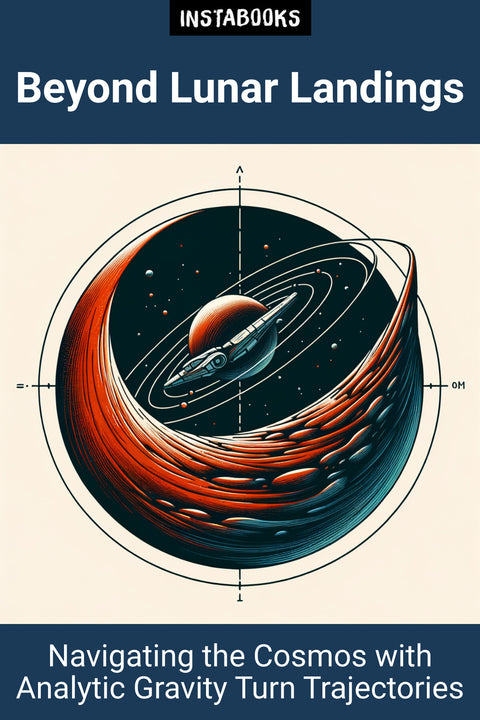
Beyond Lunar Landings
Navigating the Cosmos with Analytic Gravity Turn Trajectories
Included:
✓ 200+ Page AI-Generated Book
✓ ePub eBook File — read on Kindle & Apple Books
✓ PDF Print File (Easy Printing)
✓ Word DOCX File (Easy Editing)
✓ Hi-Res Print-Ready Book Cover (No Logo Watermark)
✓ Full Commercial Use Rights — keep 100% of royalties
✓ Publish under your own Author Name
✓ Sell on Amazon KDP, IngramSpark, Lulu, Blurb & Gumroad to millions of readers worldwide
Introduction to Terminal Soft Landing Guidance Laws
Have you ever been captivated by the intricate dance of celestial vehicles as they safely land on the rugged terrains of the Moon or Mars? "Beyond Lunar Landings: Navigating the Cosmos with Analytic Gravity Turn Trajectories" is your guide to understanding the sophisticated realm of terminal soft landing guidance laws. This book delves deep into the methodologies that ensure safe and precise landings on extraterrestrial surfaces, focusing on the groundbreaking technique of using analytic gravity turn trajectories.
The Gravity Turn Trajectory: A Game-Changer
The gravity turn trajectory is a true game-changer in space exploration. This method is designed for crafting safe descent paths with its unique concave down shape, allowing for obstacle avoidance and maintaining the correct attitude during landing. By aligning the thrust vector with the gravitational pull at the critical moment, it ensures vehicular stability and prevents tilting - all without the need for heavy computational resources.
Mastering Nonlinear Control with Precision
Delve into the nonlinear control laws that are pivotal in tracking reference velocity vectors accurately. This section elucidates how such controls guarantee finite time error convergence, making them indispensable even with limited computational capabilities. It's all about ensuring robustness against disturbances, crucial for missions lacking the luxury of extensive time and computational power.
Safety through Ground Collision Avoidance
Safety is paramount when it comes to interplanetary landings. This book expands on the guidance law's capability to incorporate ground collision avoidance techniques. By taking into account the gravity turn trajectory's shape, this method prevents ground collisions, offering a safer descent path - a vital component for missions like Apollo and Artemis.
Advancements in Space Landing Technologies
Stay ahead of the curve with a dedicated section on recent advancements. Learn how these innovations enhance landing precision while optimizing safety without burdening systems with excessive computations. The book also provides a comparative analysis with existing non-iterative methods, showcasing superior fuel efficiency, robustness, and practical applications of these guidance laws.
The Essence of Space Exploration Missions
Finally, connect the guidance laws' relevance to historic and future explorations. Understand their significance in iconic missions and their potential transformations in upcoming ventures to Mars. This book invites you to explore the cosmos with analytical mastery and enhanced safety. "Beyond Lunar Landings" is not just a book - it's your passport to the stars.
Table of Contents
1. Introduction to Space Landings- The Evolution of Landing Techniques
- Why Precision Matters
- Challenges in Space Descent
2. Understanding Gravity Turn Trajectories
- Concept and Mechanics
- Benefits for Safe Landings
- Historical Applications
3. Engineering the Descent Path
- Designing Trajectory Curves
- Trajectory Alignment with Gravity
- Real-world Implementations
4. Nonlinear Control Laws Explained
- Fundamentals of Nonlinear Control
- Tracking Velocity Vectors
- Finite Time Error Convergence
5. Ground Collision Avoidance Mechanisms
- Predicting Collision Risks
- Innovative Avoidance Techniques
- Case Studies in Recent Missions
6. Comparative Analysis with Traditional Methods
- Advantages over Non-iterative Techniques
- Performance Metrics
- Simulation Results
7. Recent Technological Advancements
- Safety Enhancements
- Precision Landing Improvements
- Resource-efficient Solutions
8. Role in Apollo and Artemis Missions
- Apollo's Legacy in Lunar Landings
- Artemis: The New Frontier
- Lessons Learned
9. Beyond the Moon: Mars Explorations
- Unique Challenges on Mars
- Adapting Techniques for Mars
- Potential Future Missions
10. Implementing Guidance Laws in Practice
- Practical Considerations
- Challenges and Solutions
- Case Studies
11. Future Directions in Space Landing
- Next-gen Guidance Laws
- Integration with AI and Robotics
- Global Collaborative Efforts
12. Conclusion: The Path Ahead
- Summarizing Key Insights
- Impact on Future Missions
- Final Thoughts and Opportunities
Target Audience
Aerospace professionals, engineering students, and enthusiasts interested in space exploration and landing guidance technologies.
Key Takeaways
- Understand the mechanics of gravity turn trajectories for safe planetary landings.
- Explore nonlinear control laws for robust navigational accuracy.
- Learn about ground collision avoidance in landing systems.
- Compare new methodologies with traditional space landing techniques.
- Discover advancements enhancing landing safety and precision.
- Connect the guidance laws' applications in Apollo and Artemis missions.
